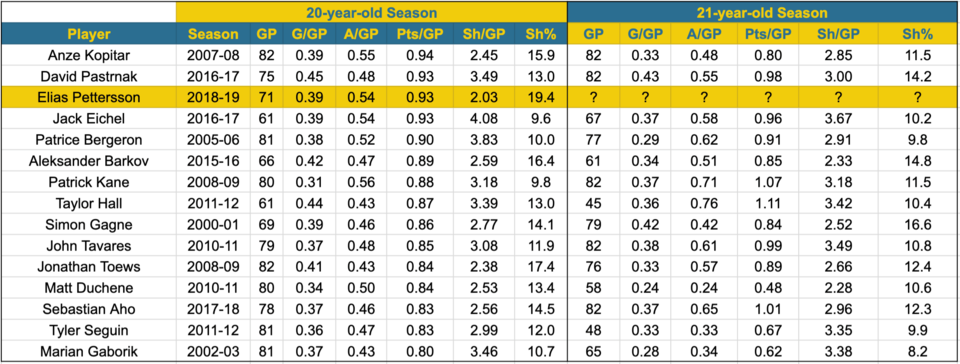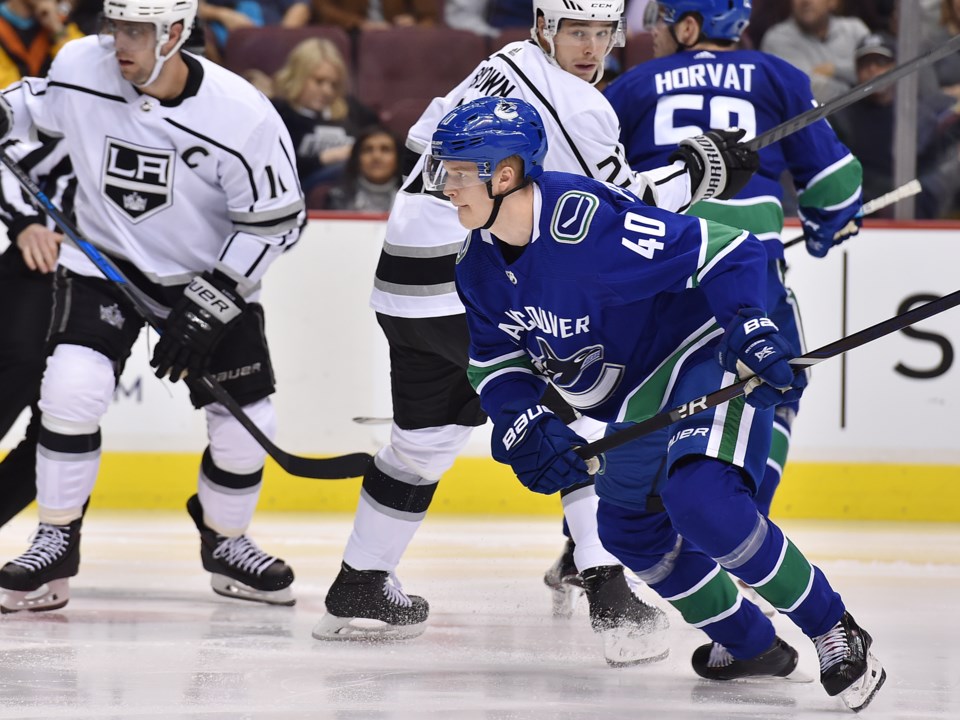Elias Pettersson had a fantastic rookie season that blew expectations out of the water, but it arguably could have gone a lot better.
Sure, Pettersson led all NHL rookies in scoring by a wide margin. Sure, he broke Pavel Bure’s and Ivan Hlinka’s franchise record for points from a Canucks rookie. Sure, he won the Calder Trophy as the NHL’s rookie of the year. But he also suffered a couple injuries that limited him to just 71 games and saw his scoring slow down in the back half of the season, with just 2 goals in his last 23 games.
There was a distinct sense that Pettersson was capable of so much more, that his record-breaking rookie season was barely scratching the surface. But how much more can Canucks fans expect from their underbarn? How high should expectations be for Pettersson in his sophomore season?
To get a better picture of what we might expect, I looked for players who performed similarly in their 20-year-old seasons. Using Hockey Reference, I looked across the last 20 years for comparable players that scored at a similar rate of goals and points per game at the age of 20. Unsurprisingly, a bunch of star forwards jumped out.

These are all players that turned 20 by the end of January in their respective seasons. Pettersson was 19 to start the season, but turned 20 in November.
All of these forwards are legitimate star players, with multiple Hart, Selke, and Lady Byng trophies among them, along with many end-of-season All-Star Team nods. This is a compelling list of comparable forwards, with nary a bust among them. It feels fitting: Pettersson belongs alongside the likes of Patrice Bergeron, John Tavares, David Pastrnak, Jonathan Toews, and Anze Kopitar.
So, how did these players perform in the year following their 20-year-old season?
Taking the average scoring rate of this group of 14 players at the age of 21, we get an average season of 28 goals and 71 points over the course of an 82-game season. That seems like a safe, reasonable expectation for Pettersson. It’s a lower scoring rate — Pettersson had 28 goals in 11 fewer games as a rookie — but it’s still a solid season that would have placed him inside the top-50 in scoring among forwards in 2018-19.
Pettersson, however, has a knack for outperforming expectations. What is the upper bound of what we could expect from him next season? We could look to the top-three performances from this list, the ones belonging to Taylor Hall, Patrick Kane, and Sebastian Aho.
Hall dominated as a 21 year old, putting up 16 goals and 50 points in 45 games in the lockout-shortened 2012-13 season, which works out to around 29 goals and 91 points over 82 games. That landed him 9th in the NHL in scoring and he led the Oilers to...miss the playoffs for the seventh time in a row. Hm, up until that last part, this sounded pretty good.
Kane had 30 goals and 88 points in 82 games as a 21 year old in the 2009-10 season. Like Hall, he was 9th in the NHL in scoring, but was also named a First-Team All Star, because there just aren’t enough good right-wingers in the NHL. And also because Martin St. Louis was robbed. In any case, 88 points would be pretty fantastic for Pettersson.
Then there’s Aho, whose 21-year-old season was this past one. Aho led the Carolina Hurricanes in scoring with 30 goals and 83 points in 82 games, earning himself some Hart and Selke votes in the process. He’s an intriguing comparable for Pettersson because they both excelled in European men’s leagues in the year following their draft, Pettersson in the SHL and Aho in the Finnish Liiga.
So there are some higher targets for Pettersson in his sophomore season: 30 goals and 83-91 points.
What he needs to avoid is the Matt Duchene season. In 2011-12, Duchene suffered knee and ankle injuries that limited him to 58 games. He played hurt through a lot of those games as the Colorado Avalanche pushed, unsuccessfully, to make the playoffs. He finished with just 14 goals and 28 points in 58 games.
That may not be the worst-case scenario for Pettersson, but it would still be a tremendous disappointment.
The most intriguing comparable is Jack Eichel, whose rate of goals, assists, and points at the age of 20 were identical to Pettersson’s last season. There are plenty of parallels between Eichel and Pettersson: they play for expansion cousins; they’re both young first-line centres that lead their teams in scoring; and they’re franchise forwards that were, in a sense, consolation prizes for not winning the draft lottery.
If Pettersson follows in Eichel’s footsteps, that wouldn’t be too bad. Eichel averaged just short of a point per game at 21, though injuries limited him to 67 games. Over 82 games, Eichel’s scoring rate would have resulted in 30 goals and 78 points.
The biggest difference between Pettersson and Eichel, and an area of concern, is Pettersson’s shot rate. He simply does not shoot the puck at the same rate as other star players and it could limit his ability to rack up goals.
The difference is stark when you look at Eichel, who shot the puck almost twice as much at the age of 20, but his shooting percentage was less than half of Pettersson’s. They scored at the same rate, but got there in a very different fashion.
Generally speaking, shooting percentages fluctuate significantly from season to season, because individual skill isn’t the only thing that determines whether a shot hits the back of the net. The skill of opposing goaltenders plays a factor, of course, but luck also plays a large role, from random deflections off sticks and shinpads, to shots that are centimetres off target and hit a post or crossbar instead of going into the top corner of the net.
It’s fair to assume that Pettersson won’t be able to score on 19.4% of his shots next season, which was the sixth highest shooting percentage in the NHL among players with at least 100 shots.
That said, Pettersson’s elevated shooting percentage has been a concern since he was in the Allsvenskan. He had a 17.8% shooting percentage in his draft year, which raised questions about the sustainability of his production, but then he went to the SHL and led the league in scoring with an even higher shooting percentage: 21.24%.
So maybe this is just who Pettersson is: an elite sniper fully capable of maintaining a high shooting percentage. It’s certainly possible, given how choosy he is about when he shoots and his ridiculously accurate shot. It’s just unlikely that he’ll be able to keep it that high every season.
Even an elite sniper like Steven Stamkos, who has had several seasons with a shooting percentage above 19%, can’t keep it that high forever. Stamkos’s career shooting percentage is 16.9%, and if Pettersson can maintain that kind of percentage over his career, he’ll be doing very well for himself.
So, a key for Pettersson will be getting himself more opportunities to shoot the puck to make up for a (hopefully slight) decline in his shooting percentage. Getting more consistent feeds on the power play would help, and maybe that’s an area where Quinn Hughes could help.
Finally, one more note of optimism: one thing that sets Pettersson apart from this group of comparable players is that his 20-year-old season was also his rookie season. Every other player on this list had already been in the NHL for at least one season, which makes sense. If you’re good enough to put together the kind of season Pettersson did at 20, you’re good enough to at least play in the NHL at 19 or even 18.
Unlike the other players on this list, Pettersson didn’t have a season or two of experience under his belt heading into last year. Instead, he was jumping in blind and still making a big impact.
While there’s a possibility of a sophomore slump, it’s almost like Pettersson has already experienced that with his slump at the end of his rookie season. It seems more likely that the year of experience will help Pettersson surpass expectations yet again in 2019-20.



